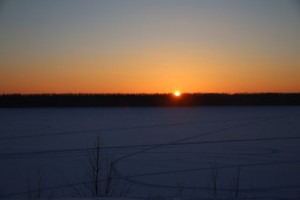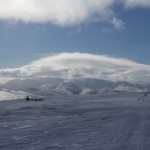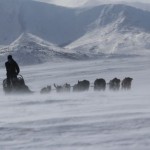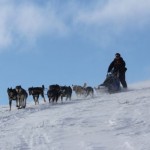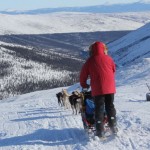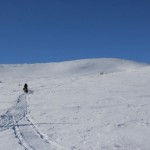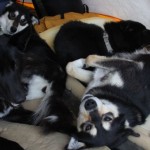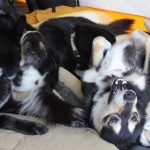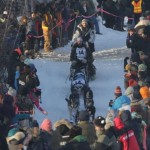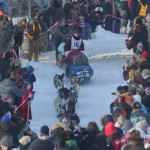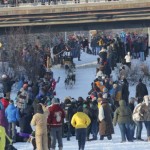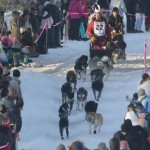A little bit of Yukon Quest analysis. The 1000 Mile Yukon Quest, this year starting in Fairbanks and finishing in Whitehorse, is about to come to an end. For the winning teams it already has ended a few days ago, others still have 160 miles to go. Hugh Neff captured his second Championship since 2012. He did it with a move from behind after the half way checkpoint of Dawson City. In the Yukon Quest a musher must take a 36 hr. layover in Dawson City, as opposed to a 24 hr. layover in the Iditarod. The other difference is, the layover is always in Dawson City and a musher can not freely choose the stop at any checkpoint, like they can do in Iditarod. The longer rest time was initiated many yeas back by Iditarod Champion Joy May and has remained the same with the exception of 2015 when a 24 hr. format was tried and quickly abandoned again. Yes, Dawson City is a very cool place and 36 hrs there is a true treat for the Musher. Hugh Neff often claims, that is why he is running the Quest, to go to Dawson City.
- Eagle Summit
- Going over Rosebud Summit
- Windy up
- 2015 Quest Rookie of the year, still being a ” mushing tour client ”
- down Eagle Summit
- Almost all the way down Eagle Summit
Now when I wrote Hugh won with a move from behind, that word “behind” is a bit misleading. In racing these days nobody really comes form behind anymore. Behind just means staying within striking distance, close to the leaders, by a few hours, usually not more than 3 hrs behind. Hugh played that game masterfully this year. The first team to Dawson City also gets 4 ounces of gold, donated by the Feller Family of Dawson City. That makes it very tempting to get to Dawson first. Unfortunately, historically speaking, the first team into Dawson is not the winning team into the finish line, most of the time. That held true once again this year. The first time Hugh was actually leading the race, and only for a few miles, was near Eureka Dome, some 70 miles past Dawson. From then on the 3 lead teams played leapfrog and their different strategies would converge in Braeburn, the last Checkpoint.
Back in my beginning days of racing, some 10 plus years ago, the common rhythm of run and rest was 6 on and 6 off. Matter of fact there is a beautiful movie ( copies are hard to get ) bearing exactly that title. The Yukon Quest, 6 on 6 off. While my racing days became more competitive, so did the run and rest schedule. Within a few short years it was more common to run 8 and rest 4, thus going from a 1:1 ratio to a 2:1 ratio. Those were also the days were several mushers attempted to run both the Yukon Quest and Iditarod in the same year and Lance Mackey becoming a master of that game, winning both races back to back. Whereas before it was said to be impossible to do well in both, never mind win both, Lance did so in 2007 and 2008. It has not been done ever since. I myself came close with winning the Quest in 2009 coming in second the same year in Idtarod, Hans Gatt winning the Quest in 2010 and also 2nd in the Quest in 2010. Looking at these numbers it is very worthwhile to keep an eye on Hugh Neff in Iditarod 2016. Despite always downplaying the importance of trophies, Hugh is very motivated to do well and I am sure he has his eye on “ winning the double “.
- Tent time
- relaxing
- better than sleeping outside
- in the tent
Let’s look again at the above quoted run and rest ratios. It is amazing what these sled dogs (and mushers) can do. This year’s Yukon Quest saw a more moderate starting pace. In other years, mushers only rested their teams about 2 to 2.5 hrs during their very first rest stop This year, they all rested 4 plus hours. That was a somewhat unusual Quest start, specially considering relatively good trail conditions. Even past the first couple of runs, nobody did any out of the ordinary moves. Runtimes were mostly capped at 8hrs, with the exception of Hugh doing a straight run from Central to Circle, after taking a good long rest in Central. The race always heats up when teams go into their 36 hr. layover in the Quest. Here the first 4 teams, Brent Sass, Allen Moore, Hugh Neff and Matt Hall clearly separated themselves from the “rest of the pack“, with only doing 2 runs for a 150plus mile stretch over some pretty hilly terrain. Hillier than ever with a trail re-route over the Top of the World Highway. The name Top of the World says it all. 36 hrs. is a long time to rest for a dog team and once leaving from there, the race is on. This year, that saw another race within the race, into the next mandatory layover of 8 hrs., which is roughly 350 miles from Dawson City and 90 miles before the finish line in Whitehorse. Mushers sometimes talk about, how they already think about “ next year’s strategy “ while running this year’s race, as Brent Sass commented at the Whitehorse Finish line. I wonder when and where Hugh started thinking about the schedule he decided to run, as indeed, that had never been done in this fashion before, thus most likely caught both Brent and Allen a bit by surprise. To really understand what Hugh and the other mushers did during that part of the run, warrants looking closer at the run and rest times, number of rests too.
Brent was in the lead out of Dawson City. From looking at past years’ races I would have pegged him to do the longest runs and shortest rests. Yet he did the exact opposite, I assume mostly due to fighting a cold himself and not feeling all that well.
It took Brent 6 runs to reach Braeburn; that has been done in 4 runs before quite a few times, specially in the Lance Mackey days. Matt Hall and Allen Moore both ran in 5 runs to Braeburn, Matt never resting longer than 3.5 hrs. and Allen throwing a couple of 4 hr. rests in there. Hugh Neff basically did run it in 4 runs, although the one run, through Pelly Crossing, has a short 1hr 20 minute stop in there. That is where he separated himself from the others.
So in numbers 350 mile run.
Brent Sass 6 runs, total rest of 15 hrs,
Matt Hall 5 runs, total rest of 12.5 hrs.
Allen Moore 5 runs, total rest 14 hrs.
Hugh Neff, 4 runs, total rest 11.5 hrs.
During this part of the race, all the above teams did a near 4:1 Run to Rest ratio. Simply amazing, specially considering how well each team looked at the finish line. Long runs and short rests are no reason for an outcry. As a comparison, the 300 Mile Kusko 300 requires a musher to take 10 hrs of rest on 300 ( tough ) miles. That is why a k300 run offers some very valuable training and experience, like no other race, in preparation for a 1000 Mile run.
- Quest Start 2016
- Quest Start 2016
- Quest Start 2016
- Even more people will line the trail at Iditarod 2016
- Even more people will line the trail at Iditarod 2016
- Even more people will line the trail at Iditarod 2016
Also to keep in mind, really long runs have been done in Iditarod before too. During my last race in 2011, Ramey Smyth did an amazing come from behind, almost catching John Baker. He ran on a mere 2.5hrs of rest all the way from Unalakleet to White Mountain, a similar move as Hugh’s Quest move, he ran into his 8 hr. layover in White Mountain. The real tough part for dogs and musher at that late point in the race is to stay awake that long, and still being able to think straight. One thing essential for those long runs is a fast team. Ramey at the time was 50 minutes faster than me from Eagle Island to Kaltag. That alone is huge. Now combine that with also resting shorter and it’s a winning combination. Hugh did post the fastest trail times leaving Dawson City over the others. He seized the moment and cruised into victory during the Yukon Quest 2016.
Who is getting excited for Iditarod 2016??? Heck ya!!!!! Happy trails, Sebastian
